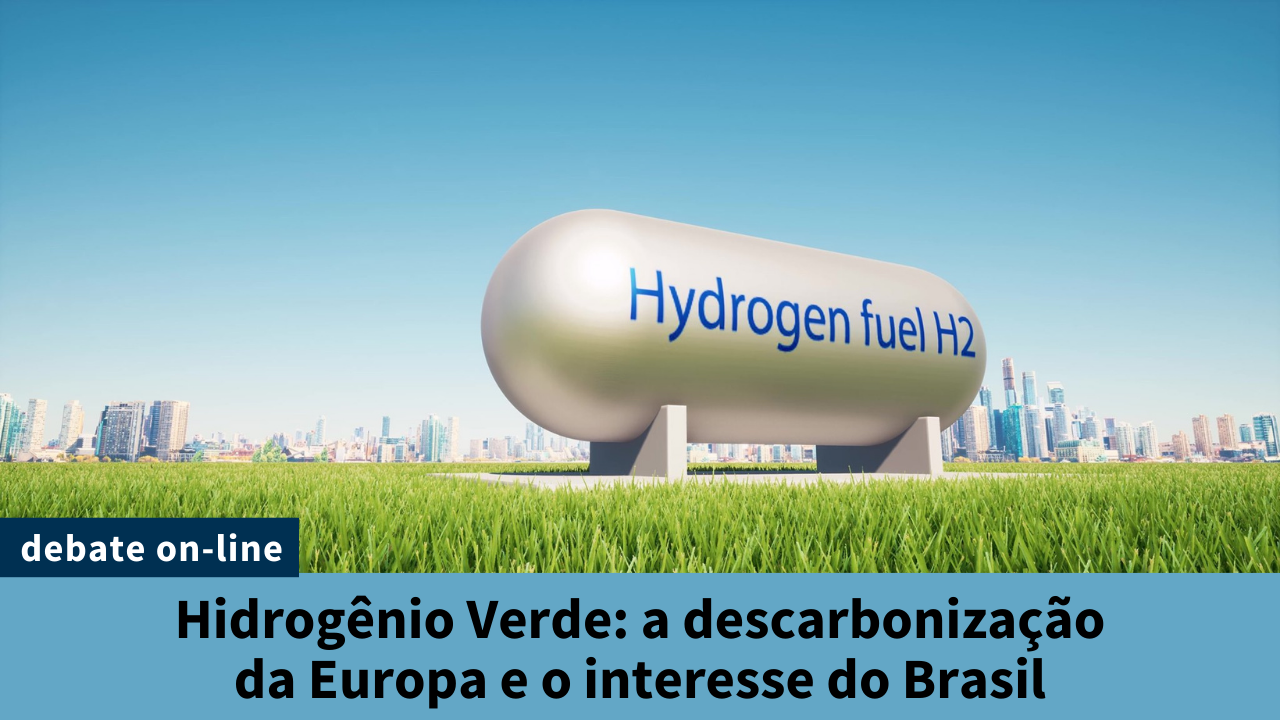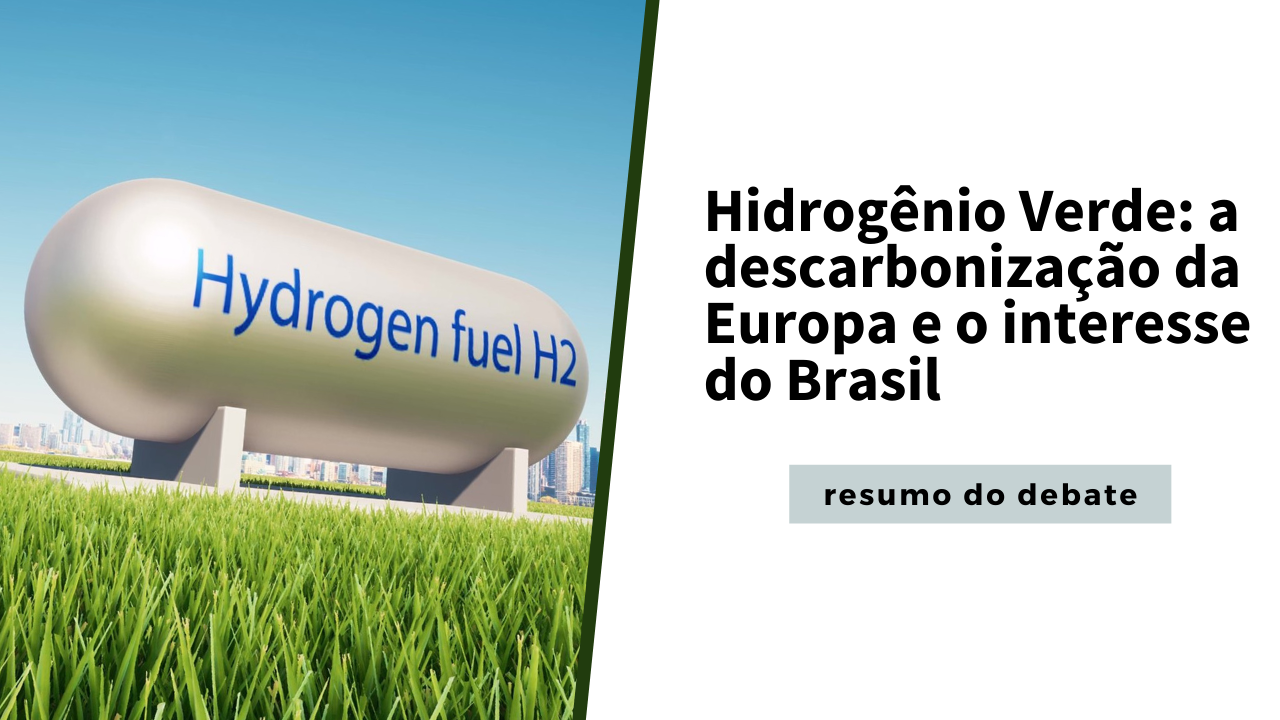With an energy mix that is 85% sustainable, Brazil has enormous potential to be one of the leaders of the energy transition underway on the planet and could become a major exporter of green hydrogen, which by 2050 should account for 20% of all energy consumed in the world, generating US$ 2.5 trillion per year. “Brazil is known today for being an exporter of commodities that are the product of the exploitation of the environment, such as iron ore and soy. But the country has everything it takes to embrace green hydrogen and set a global benchmark for the development of this technology that will change the world,” said Ansgar Pinkowski, manager for Innovation and Sustainability at the Brazil-Germany Chamber of Commerce and Industry in Rio de Janeiro and head of the project Sector Mapping of Green Hydrogen in Brazil.
The European Union and Germany, in particular, trust green hydrogen to decarbonize their economies and see Brazil as an important supplier of this commodity. In addition to casting light on the position Germany has taken on this matter, the webinar discussed how Brazil can take advantage of the international increase in demand for green hydrogen. This depends on internal policies, but also on clear rules on the acquisition of green hydrogen by Germany and other interested European countries. As one of the participants said in the webinar, transparency and rationality will be required from both sides.
“Besides being critical for Brazil to meet the goals under the Paris Agreement (2015), green hydrogen is also an opportunity for economic development and geopolitical repositioning,” said Paulo Alvarenga, CEO of Thyssenkrupp in Latin America and vice president of the Brazil-Germany Chamber of Commerce and Industry.
“With complementary renewable energy sources — solar, wind, biomass and hydro — Brazil has the capacity to run an electrolysis plant in a sustainable way 24 hours a day, producing 100% green hydrogen. Now, it is no use selling renewable energy to Europe and at the same time relying on non-renewable sources such as thermal power plants to meet domestic energy needs. The goal is to reduce carbon emissions at a global level, but it has to make sense to everybody,” explained Professor Jerson Kelman, who teaches at the Post-graduate Engineering Research Institute Coppe/UFRJ and served as a director at the National Water and Basic Sanitation Agency and at the National Electrical Energy Agency.
“Brazil should aim to be an exporter not only of green hydrogen, but also the technology needed to produce it. To achieve this goal, we need public policies that strengthen this entire new technological chain, including manufacturing electrolysers, building factories, storing and transporting the product in a sustainable and safe manner,” said Italo Freitas Filho, vice-president of New Business Development at AES in South America.
The four engineers participated in the webinar “Green Hydrogen: the decarbonization of Europe and why it is interesting to Brazil,” held by the FHC Foundation and the Consulate General of Germany in São Paulo.
As BBC Brazil explained in a report released in April this year, hydrogen is the most abundant chemical element in the universe and stores three times more energy than gasoline. Unlike gasoline, however, hydrogen is a clean source of energy as it only releases water (H2O) in the form of steam and does not produce carbon dioxide (CO2). Hydrogen is present in water, along with oxygen, and combines with carbon to form hydrocarbons such as gas, coal and oil. To be used as fuel, it needs to be separated from the other elements. Until now, hydrocarbons were used to generate energy, polluting the environment by releasing CO2. The production of hydrogen from renewable energies, including solar and wind, through a process called electrolysis started a few years ago. The result is the so-called green hydrogen, which is 100% sustainable but more expensive to produce. Many believe it can be a green solution for some of the most polluting industries, such as transportation, chemicals, steel and power generation.
“There is no planet B”
“By signing the Paris Agreement at the end of 2015, most countries committed to the goal of limiting the rise in global temperature to 1.5 degrees Celsius. This can only be achieved if we make radical changes to the way we produce and consume energy. We can no longer look for energy sources in the dephths of the earth or the sea, use oil, gas and coal to meet our energy needs and release carbon dioxide, a by-product of this consumption, into the atmosphere. Green hydrogen, which is obtained by splitting water into hydrogen and oxygen, is the key to make this fundamental energy transition,” Pinkowski said.
“There is no planet B,” Alvarenga agreed. According to the Brazilian executive, just to replace the gray hydrogen produced in the world today from hydrocarbons (96% of the market) with green hydrogen, it would be necessary to install 800 gigawatts of electrolysis capacity (separation of water into hydrogen and oxygen). Just to have an idea of how much that represents, the entire Brazilian production capacity is currently at around 200 gigawatts, including the various energy sources available in the country. “Thyssenkrupp, one of the world’s leading companies in this new technology, currently has only 10 gigawatts of installed capacity to produce green hydrogen. By 2050 we aim to have 3,300 gigawatts to ensure sustainable energy for our customers. It is a market with enormous potential,” he stated.
Germany takes the lead in funding the transition
Germany — Europe’s leading economy and the fourth largest in the world — has earmarked nine billion euros to significantly increase the share of green hydrogen in energy supply in the coming years. Out of this total, two billion euros should be used to foster the transition in other countries too. “The best thing the German government can do to boost this new market globally is to hold international auctions for long-term green hydrogen supply. The countries that make the most advantageous proposals will close the deal. There is no doubt that it would be a great opportunity for Brazil, but not just for us,” said Kelman.
“Germany has created a foundation to foster competition between countries by holding clean energy auctions,” Pinkowski explained. According to him, the two billion euros will be used to amortize the cost differences between green hydrogen (produced from water) and gray hydrogen (from fossil fuels) during the transition phase. “We will not invest directly in factories, but we will seek to encourage production efficiency around the world with the goal of accelerating the necessary changes in the energy sector,” explained Pinkowski.
“Brazil has everything it takes to benefit from this great opportunity. But it cannot repeat the mistakes made in the past, such as when it wasted its potential of exporting ethanol to Europe,” said Alvarenga, after listing the reasons why he believes in Brazil’s potential to be a supplier of green hydrogen: it is an important economy in the democratic world, with a regulatory system that needs improvement but is a good starting point; it has enormous potential for generating renewable energy, especially in the Northeast of Brazil, whose coast is closer to Europe; and it has a significant domestic market that can help leverage the production and consumption of green hydrogen.
For Freitas Filho, the cost of producing renewable energy, especially wind and solar, has been falling year after year and electrolysis will be next: “AES sees green hydrogen as a major challenge, as the entire supply chain, production, and distribution need to be adjusted so that this green fuel becomes a reality and can be produced in the required volume and at a competitive price to the final consumer.”
“We are witnessing the beginning of an energy revolution and Brazil, with its abundant sunlight, wind and water, is in a privileged situation. We can also use biomass —such as ethanol— to produce green hydrogen, but it can only be sustainable if it does not harm food crops and does not result in an increase in planted areas in threatened biomes such as the Amazon and the Cerrado,” said Pinkowski. Another point of attention is how green hydrogen is transported. If ships powered by hydrocarbons are used, its transportation will contribute to air pollution.
Different shades of green
“In the green hydrogen production process, there are different shades of green. Which of these shades are acceptable and which are not? We will need a pact of rationality and a lot of transparency to be successful in this transition,” said Kelman. The former president of Sabesp —the Basic Sanitation Company of the State of São Paulo— also observed that the production of green hydrogen requires a considerable amount of water, which is a challenge even in a country with abundant water resources like Brazil. “It is not an unsolvable problem, but it needs attention,” he said.
“Ideally, green hydrogen should be carbon-free from the beginning to the end of the production, distribution and consumption chain. We know, however, that it takes some time for the various technologies to mature. This is the case, for example, of ships powered by green ammonia, which will still take some time to become a reality. Germany will use its economic and technological strengths to make this happen,” Pinkowski said.
“Who are Brazil’s potential competitors in this new green hydrogen market?” asked Sergio Fausto, director of the FHC Foundation and moderator. “The countries that have the most potential are those with a good capacity to produce solar and wind energy and that have easier access to the main centers with the greatest energy consumption. Brazil and Colombia, for example, can benefit from the sale of green hydrogen to the European market, which is right there across the Atlantic. In the Pacific region, Chile and Australia have easy access to the Asian market, especially China, Japan and South Korea. Argentina, Morocco and Saudi Arabia can also tap into this new market,” replied Italo Freitas Filho.
“It will take all countries capable of participating in this sector and all possible technologies to develop this market at the required speed and volume. Competition is positive in maximizing results, not excluding any potential producer,” Alvarenga concluded.
Otávio Dias is a journalist specializing in politics and international affairs. A former correspondent for Folha in London and editor of the estadao.com.br website, he is currently the content editor at Fundação FHC.
Portuguese to English translation by Marília Aranha.











